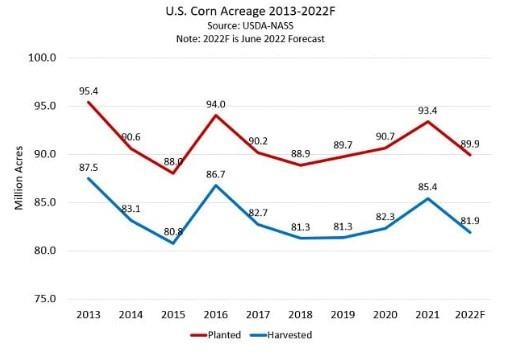By James Mitchell
Last week USDA-NASS published their annual June Acreage report. The report provides state-level planted and harvested acreage estimates for all principal crops. We can compare estimates from the June Acreage report to estimates from the March Prospective Plantings report and last year’s planted acreage. We also need to consider changes in total planted acreage versus shifts in planted acreage among competing crops. For this newsletter, we are going to review planted acreage for corn, soybeans, and hay.

Total planted acreage for 2022 is 316.3 million acres, a 0.3% decline from 2021. USDA’s total planted acreage estimate reflects a 0.3% downward revision compared to their March estimates. In the report, USDA notes that excessive rainfall had delayed planting in Minnesota, North Dakota, and South Dakota at the time of data collection. These states accounted for 19% of principal crop acreage in 2021. We will likely see revisions to acreage estimates based on further data collection by USDA in those three states.
Corn acreage estimates in the June Acreage report agreed with industry expectations. USDA estimates corn planted acreage for 2022 at 89.9 million acres or 3.7% lower year over year. Corn planted acreage was adjusted 0.5% higher than estimates in the Prospective Plantings report. Despite record fertilizer prices, strong corn prices likely encouraged some producers to plant more corn than expected in March. Still, year-over-year declines in corn acreage in the Corn Belt range from 5.6% in Indiana to 1.6% in Iowa. In Minnesota, North Dakota, and South Dakota, USDA estimates that corn acreage will be 1.2%, 26.8%, and 4.1% lower year over year.
Soybean acreage estimates were a surprise to industry experts, with most expecting much higher planted acreage. USDA estimates soybean planted acreage at 88.3 million acres, or 1.3% higher year over year. Soybean acreage was revised 2.9% lower from previous estimates. Indiana (1.8%) and Kentucky (2.5%) were the only significant states to have their planted acreage adjusted higher.
USDA estimates harvested hay acreage at 51.5 million acres, a 1.5% increase year over year. In March, USDA estimated that hay acreage would be down 0.8% compared to 2021. USDA’s revised estimate for June reflects an adjustment of 1.2 million acres. Hay is a regional market, and it’s essential to consider the range of estimates across states. For example, in Texas, the largest hay-producing state, acreage is estimated to be 12% lower in 2022. In Arkansas, USDA estimates an increase in hay acreage of 1.7%. Hay acreage in Missouri and Oklahoma is expected to be 4.1% and 1.0% lower, respectively.
It’s encouraging to see higher year-over-year harvested hay acreage. However, when we look at the drought map, there is still much to be concerned about regarding the forage outlook. High fertilizer prices, drought, and poor pasture conditions could put us in a tight spot this winter. At the same time, supplemental feed will be more expensive this year, with corn expected to average $6.75/bu. Now is the time to start planning for a range of alternative scenarios.
Source : osu.edu